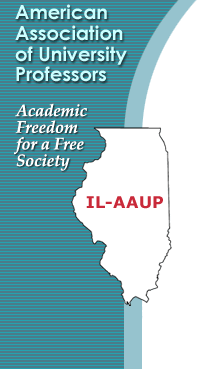Home | IL Academe | About IL AAUP | Conference Corner | Calendar | Services | Committees | Contact Us | Grants | Reports | Links
 |
 |
 |
The War on Science
The March for Science in Washington DC, and in more than 600 cities around the world, was held this year on April 22, Earth Day. Although the organizers proclaimed the march was to support science, in reality, it was clearly a march protesting against President Donald Trump and his anti-science positions. Trump has referred to climate change as a “hoax.” He has supported funding cuts to the National Science Foundation, the National Institute of Health, the Environmental Protection Agency, and other science-related government organizations. This March for Science and related activities were unprecedented for the scientific community. The current Trump-led attack on science is put into perspective in Shawn Otto’s excellent book, The War on Science, which describes the history of this and other anti-science movements especially in the United States. One example Otto discusses is William Proxmire, Democratic U. S. Senator from Wisconsin, who established his Golden Fleece Awards for what, in his opinion, was wasteful government spending on scientific research projects. The Proxmire attack on science targeted the United States Department of Defense, Bureau of Land Management, National Park Service, and National Science Foundation. His attacks lasted from 1975 to 1988 creating adverse publicity and reducing public support for scientific research. Fortunately, he retired from his Senate position in 1988 but similar types of “awards” live on with other organizations that condemn government spending of taxpayer money on scientific research. Anti-science is also still alive and well today in Dayton, Tennessee. Dayton is the location of the 1925 “Monkey Trial” of John Scopes, a science teacher at the local high school. In May 1925, the Tennessee legislature enacted the Butler Act, making it illegal to teach evolution or that man had developed from a lower form of life. To challenge the law, local citizens persuaded Scopes to state that he had taught evolutionary concepts to his high school class. Scopes was arrested, tried at the Rhea County Courthouse in Dayton in a trial that lasted eleven days, found guilty and fined $100. Williams Jennings Bryan was one of the prosecutors; Clarence Darrow defended Scopes. The verdict against Scopes was later overturned on a technicality, but the Butler Act remained Tennessee law for 42 years until it was finally overturned in 1967. The trial drew newspaper reporters from around the country and was later the focus of the stage play and the Academy Award winning movie Inherit the Wind. A few years after the trial, Bryan College, an evangelical Christian school named after William Jennings Bryan, was formed and still exists in Dayton today. In 2005 on the 75th anniversary of its founding, the college erected a statue of Bryan and installed it on the lawn of the Rhea County Court House to honor Bryan’s role in the Scopes trial. This summer, 92 years after the trial and 12 years after the installation of the Bryan statute in Dayton, The American Humanists Association received permission to erect a statue of Clarence Darrow on the courthouse lawn. Because I contributed to the funding of the statute, I was invited to the dedication ceremony. When I arrived in Dayton, June Griffin, the Rhea County Tea Party leader and Pastor of the American Bible Protestant Church was quoted in the local paper objecting to the installation of the Darrow statute. According to the Dayton Times Free Press, she invited the Darrow statue supporters to form a militia and have a fire fight with her and her Christian militia at King’s Mountain. Despite the threat of violence but with the presence of State and City Police, the Rhea County Sheriff’s Department and plain clothes security, who took the threats seriously, the Darrow statue dedication ceremony was peacefully concluded. I left town convinced that anti-science feelings are still present in Dayton, Tennessee, today as they were in 1925. Basic scientific research does benefit the public good although the benefits of the research may not be obvious immediately. Mohammad Ahmadpoor and Benjamin F. Jones, both from Northwestern University, found a significant correlation between basic scientific research and the marketplace. Their analysis of 4.8 million patents issued by the U.S, Patent and Trademark Office from 1976 to 2013 and 32 million journal research articles showed that 80% of the most cited research articles through 2013 are linked to a future patent. The Ahmadpoor and Jones data supports the direct link between scientific research and viable patents and should counter the common opinion of the general public and too many politicians that basic scientific research has no practical effect. The war on science will undoubtedly continue fueled by religious objections and political ideology. Only informed support of science will enable the United States to continue as a world leader in science research rather than a leader in a race to the bottom. |
|